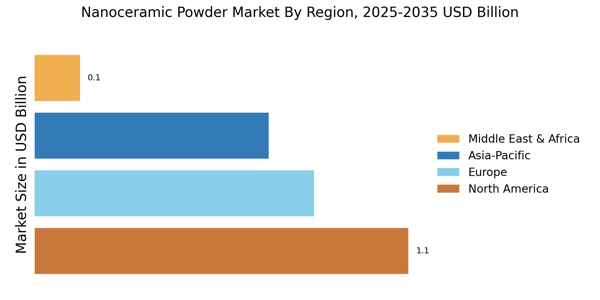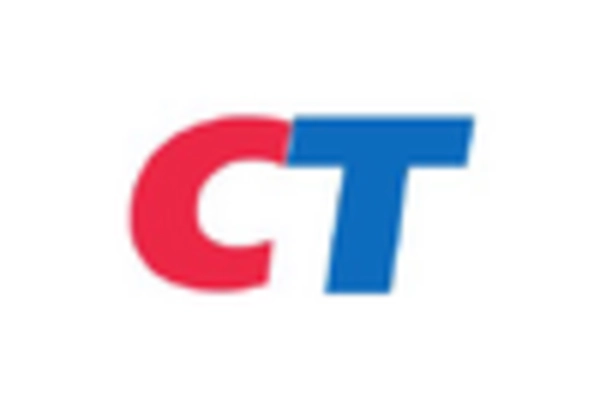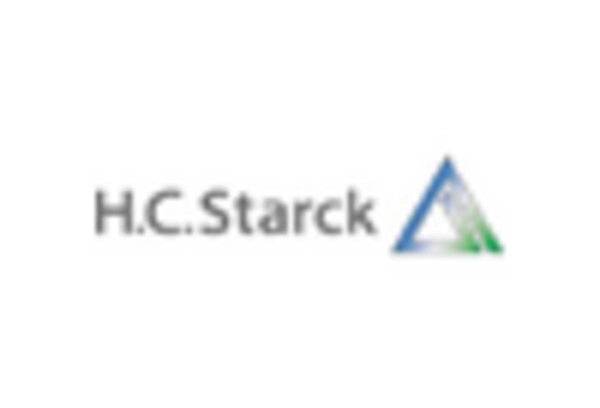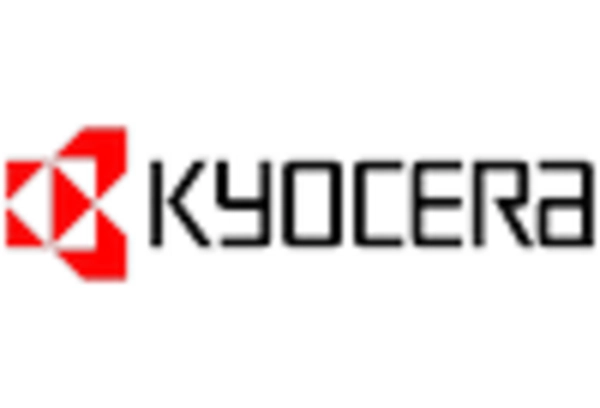Expansion in Aerospace Sector
The aerospace sector is increasingly recognizing the advantages of nanoceramic powders, which are being integrated into various applications such as thermal barrier coatings and structural components. The Nanoceramic Powder Market is likely to benefit from this trend, as the aerospace industry is projected to expand significantly, with an expected growth rate of around 5% annually. The lightweight and high-temperature resistance properties of nanoceramics make them ideal for aerospace applications, where performance and safety are paramount. Furthermore, the increasing focus on fuel efficiency and sustainability in aviation is driving the adoption of advanced materials, including nanoceramics. This expansion in the aerospace sector suggests a promising avenue for growth within the Nanoceramic Powder Market, as manufacturers strive to meet the evolving demands of this high-performance industry.
Rising Demand in Automotive Applications
The Nanoceramic Powder Market is experiencing a notable surge in demand from the automotive sector. This is primarily due to the increasing need for lightweight materials that enhance fuel efficiency and reduce emissions. Nanoceramic powders are utilized in various automotive components, including coatings and composites, which improve durability and performance. The automotive industry is projected to grow at a compound annual growth rate of approximately 4.5% over the next few years, further driving the demand for nanoceramic powders. As manufacturers seek to innovate and meet stringent environmental regulations, the integration of nanoceramic materials appears to be a viable solution. This trend indicates a robust potential for growth within the Nanoceramic Powder Market, as automotive companies increasingly adopt advanced materials to enhance vehicle performance.
Growing Interest in Energy Storage Solutions
The increasing demand for energy storage solutions is significantly influencing the Nanoceramic Powder Market. With the rise of renewable energy sources, there is a pressing need for efficient energy storage systems, where nanoceramic materials are being explored for their potential in battery technologies. Nanoceramic powders can enhance the performance and longevity of batteries, making them a focal point in the development of next-generation energy storage solutions. The energy storage market is projected to grow at a compound annual growth rate of around 8% in the coming years, indicating a substantial opportunity for the Nanoceramic Powder Market. As industries and consumers alike prioritize sustainable energy solutions, the integration of nanoceramics into energy storage applications appears to be a promising trend.
Increased Research and Development Activities
The Nanoceramic Powder Market is witnessing a surge in research and development activities aimed at exploring new applications and enhancing existing products. Academic institutions and private companies are investing significantly in R&D to unlock the full potential of nanoceramics in various fields, including electronics, healthcare, and environmental applications. This focus on innovation is expected to drive the market forward, as new findings and technologies emerge. The R&D expenditure in materials science is projected to increase by approximately 7% annually, reflecting the growing interest in advanced materials like nanoceramics. As researchers continue to uncover novel applications and improve the properties of nanoceramic powders, the Nanoceramic Powder Market is likely to experience robust growth, fueled by these advancements.
Technological Advancements in Manufacturing Processes
Technological advancements in the manufacturing processes of nanoceramic powders are playing a crucial role in shaping the Nanoceramic Powder Market. Innovations such as improved synthesis techniques and enhanced processing methods are leading to the production of higher quality nanoceramics with tailored properties. These advancements not only increase the efficiency of production but also reduce costs, making nanoceramic materials more accessible to various industries. The market for nanoceramic powders is anticipated to grow at a rate of approximately 6% per year, driven by these technological improvements. As industries seek to leverage the unique properties of nanoceramics, the ongoing evolution in manufacturing processes is likely to propel the Nanoceramic Powder Market forward, fostering greater adoption across diverse applications.


















Leave a Comment